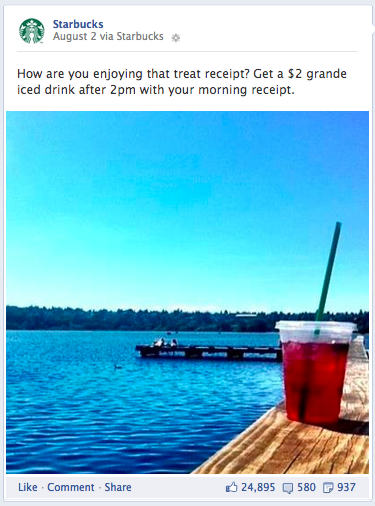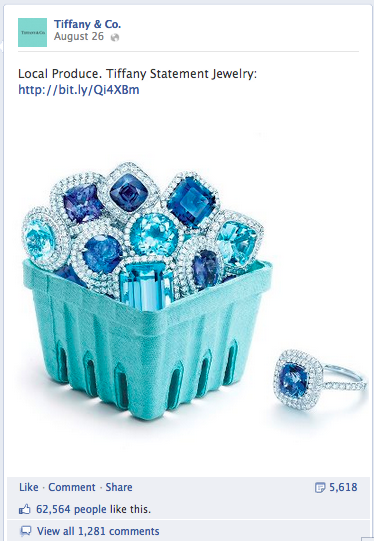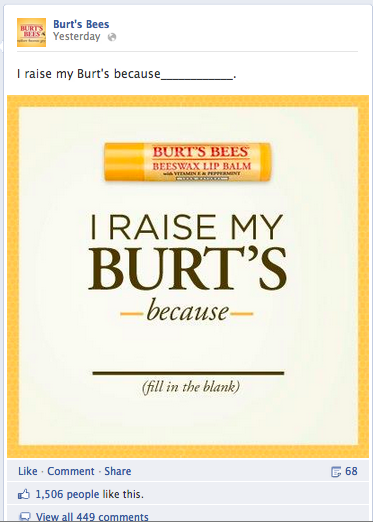Posts Tagged ‘los angeles pr’
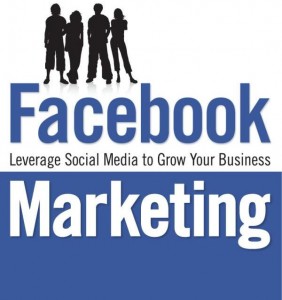
Five Steps for a More Effective Facebook Page for Small Business
Emily Weaver wrote a great tip on Manta that AJGpr, a Los Angeles Public Relations Firm wanted to share. Here it is.
Representing your small business online can be difficult, but if done the right way you can reach an unlimited amount of customers. With social networks like Facebook, Twitter and LinkedIn it makes it easier for small businesses to truly stay in touch and on track with both potential and current customers.
1. Start with a Facebook Page
Facebook is generally used for social interaction anyway, so putting your business on Facebook will be second nature if you already use it for keeping in touch with friends and family.
- If you already have a profile on Facebook, you can add a page for a company or small business. This way you can still keep your personal profile active and under the same account.
- A great way to test out any new page online is to have a focus group you can trust. Who would be better than your friends list on your profile page.
2. Stay informed, get a routine
As a small business owner you want to keep your Facebook page up to date for customers. Not only does that fall under the category of posting content on a regular basis, it also means to be realistic when it comes to results.
- Post content – a photo, a news story, what you’re doing during the day – something that customers can only get from liking you on Facebook. If you get one ‘Like’ out of it you’ll be thrilled, but don’t expect it all to come at once.
- Have a goal of what you’d like to see happen out of what you post, just don’t get too distraught over a question you ask that gets no answer. As for posting, make it a habit to update your page at least once a day.
- There never is a wrong time to post, just as there isn’t a right time to post; whenever you get the time, whenever you have the content. Make it engaging for your customers so that they can get an idea of what you’re about!
3. Update your status with style
The status can be very daunting, but it’s an open space for you to share content with your customers. That’s exciting! Before posting, you might want to map out what you want to share.
- Do some research on other brands similar to yours and see what they’re posting. For instance a local bakery might post a photo of their famous hot chocolate, or a diner could post a question about what customers would like their special to be for dinner that day- something to involve customers, something that will keep their attention.
- Don’t think your content has to be completely formal. Make it your own, and represent the voice of your small business.
- Make sure to post mostly open-ended questions or thoughts to get more of a complete response out of your fans, this way you’re communicating back and forth with the person who matters most – the customer.
4. Keep in touch with customers
This may be an easy task, or a challenging one, depending on what you want to do.
- As the owner of your small business Facebook page you’ll be able to see who has ‘Liked’ your page. One way you can keep customers engaged is by sending them a message as soon as they ‘Like’ your page. This is a great way to let your new fans know that you’re going to be there to respond and interact with them promptly.
- Another way to keep customers engaged is to answer them via the messages section onFacebook. Some may just send you spam, but others will probably have legit questions. This section is something you’ll want to keep an eye on each day.
- In addition to your daily posts, answering your customer’s questions in a timely manner can only give them a positive perception of you. By keeping in touch with customers and answering their questions and suggestions you can keep a connection with them and they’ll definitely have nothing but good things to say about you and your business!
5. What you can offer fans
Think about it- they’re ‘Liking’ your page. What do they get out of it?
- If you can get something like a promotion going for your fans, or a coupon for 10% off your latest inventory it would guarantee their satisfaction and possibly get them to spread the word about ‘Liking’ your page.
For more ideas on what to post or just for best practices, visit Manta on Facebook to get an idea of how you can use Facebook for your small business.

 AJGpr , A Los Angeles PR firm, found this great list of advice for PR professionals – especially newbies when dealing with journalists from Ragan’s PR Daily.
AJGpr , A Los Angeles PR firm, found this great list of advice for PR professionals – especially newbies when dealing with journalists from Ragan’s PR Daily.
- Don’t be afraid: Reporters need you as much as you need them – sometimes more if you’ve got an awesome, sought-after client. They are being challenged to churn out content FAST and they’re often relying on others (you) to provide insight, quotes, access to spokespeople and in some cases, help educate them on a complicated or new (to them) topic – all by deadline. It’s a mutually beneficial relationship so don’t be afraid to make that first contact – you might be surprised.
- Get connected: I don’t advise blindly connecting to every reporter you’ve ever heard of on LinkedIn, but after that first client briefing or email trail, connect with them on LinkedIn. Even easier, follow them on Twitter or Google+ and subscribe to their feed. My best media contacts are people that I’m connected to on LinkedIn and I truly believe that sometimes, because they see my face pop up on their news feed, they remember to reach out with a source request.
- Reporters need to network, too: More than ever, reporters are being measured by their social networks and how many people – hits – they can get to their stories and to then go back and share with their own networks. That is stressful! That being said, reporters know PR pros tend to be outgoing, well-connected individuals, and they may lean on you to broaden their reach. I’ve connected a few reporter “friendlies” with other PR pros for stories that have led to success for all involved. I also sometimes send a reporter, if they’re in my region, a link to a networking event they might find interesting or that I’m attending.
- Freelance writers rock: And there’s more of them then there were four years ago. Get in good with a freelancer and you won’t regret it – these are smart, driven and often very KIND people who at any given point could be writing something super niche, for a “smaller” outlet, and then next thing, contributing regularly to a column in a major business publication. Because of the nature of operating solo and/or remote from the main news hub, freelancers are more likely to reach out with a media request and ask for help.
- Share the S*** out of their news — and not just when it’s yours: You have a reporter friend and they just wrote about your client and you’re PUMPED so you like it, tweet it, send it to your Mom (don’t lie, you’ve done it). Your reporter friend appreciates this because they want more web traffic to their article and in many cases today, their boss is counting how many hits, RTs, comments, etc. that article receives. On several occasions I’ve actually had reporters email me after coverage hits to let me know “Yay! It got a bunch of comments” or “Wow! The story got X number of click-throughs” and then thanked me for sharing it on LinkedIn or Twitter. But it’s not just YOUR coverage that should be shared – like any solid PR pro you want to be consistently reading your media “friendlies” work and sharing it with your network. Reporters recognize this and will not forget you when it comes time to write another story.
To that PR newbie I would then say: At the end of the day, if you’re doing your job right, a reporter will not only see you as a resource, but as an industry peer. And that makes public relations more valuable, powerful and better in terms of what we can offer our clients.

Elena Verlee writes in her blog about the use of humor in PR. AJGpr, a Los Angeles PR firm thinks the topic is interesting enough to share with you.
Here it is:
What if there was a way for you to differentiate your PR from the rest of your competitors — but it’s slightly risky and not that easy. Would you try it?
Such a PR tool does exist. It’s called humor.
According to Marketing Profs, few companies are using humor in their marketing and PR that, whenever a company does — and does it well — it’s sure to stand out, especially among technology companies.
“High-tech suffers from terminal seriousness,” says Kathy Klotz-Guest in her article, “Humor in PR: Can You Hear Me Now?”
Companies that do harness humor in their PR are sure to catch the attention of media and the public.
Humor is also effective at engaging your target audience and getting more mileage out of social media.
“Consumers are, in fact, willing to engage with companies and brands in today’s online social forums,” says Aaron Perlut in his Forbes article, “Humor Can Create Engagements.”
Granted, using humor carries some risk. Context is everything, for one thing. If you have a global audience, your North American markets may get the joke, but your Asian markets may end up scratching their heads.
Furthermore, being funny does not excuse you from offering real news. Your PR materials, while humorous and entertaining, still have to have news value.
You have to know your audience to use humor effectively — something which is true of any type of communication, PR or otherwise.
This Brand Gets Humor Right
Many experts agree, self-deprecating humor works best. To give you an example, the satirical publisher, The Onion, once made fun of Tide in a parody article about how companies are using social media to promote themselves. The company got in on the joke, produced the fictitious video described in the article, and generated plenty of social media buzz, not to mention kudos from the writers of The Onion themselves. It was an excellent example of how a brand’s ability to laugh at itself can produce positive PR.
Click here for the original article in The Onion.
Is Humor Right for You?
The next question is, of course, whether humor is a good approach for your company or client.
I think it’s possible to find a humorous angle, if not several, in any product, service, market or industry. However, there are some things to keep in mind:
- Stay relevant. Humor brings positive PR only when it helps expand your core messages.
- Be sensitive. Humor’s impact depends on the attitudes and values of the audience. Be aware of cultural, religious, political and other sensitivities that may make your comedy backfire. This is where having a true understanding of your audience — developed through listening and interacting with them — pays off.
- Steer clear of humor bombs. Certain topics are bad jokes, no matter what. This includes child abuse, exploitation of women, racial discrimination and disabilities.

I read this interesting post on LinkedIn today by PR professional Lisa Arledge Powell that I wanted to share with AJGpr blog readers. I TOTALLY agree with Lisa’s adage “There is no circumstance when the question, ‘Did you get my press release?’ should be uttered.”
4 Things PR Pros Should Never Say To Reporters
Here is what Lisa has to say:
Our business is about relationships. In order to foster the strongest relationships possible, you want to be sure to always communicate with efficiency and strategy and never utter the following statements:
1. “Did you get my press release?” As a current PR pro and former news anchor, I think I can speak for almost every person in the media and say that there are few things more annoying than the dreaded “Did you get my press release?” phone call. Nothing in the world of PR guarantees an immediate hang-up quite like this question. If you sent it, chances are good that they got it. They’ll let you know if they are interested. If an outlet chooses not to run your story, picking up the phone and nagging them is not going to persuade them to change their decision.
2. “What types of articles do you run?” Watch and listen before pitching. Educate yourself about the media outlet and that particular reporter’s stories before pitching them. Your story angle, pitch, and everything you do relating to your media outreach should be customized, and that includes the timing of your outreach. Know the schedule for editorial meetings and deadlines and be respectful of it. If you want the media to take the time to read and fully consider your pitch, show them that you’ve taken the time to read and understand their work.
3. “This is a perfect fit for you.” When you say this, a reporter hears one of two negative things: desperation or bossiness. They might suspect that the story isn’t a perfect fit for anyone because you’re pushing too hard, or you could come across as a know-it-all. There are always internal pressures, personal preferences, and other planned stories to consider. Only the contact you are pitching knows how your idea fits into their big picture. Let them decide whether it’s a “perfect fit.”
4. “You’ll have to be quick; I don’t have much time” Understand the time involved in a reporter’s story preparation. For example, it can take several hours on multiple days for a profile piece that involves an in-depth interview and a photo shoot. Be sure that as a PR person you understand the commitment level of what you’re pitching and that you can deliver if the media is interested. You can often save time by understanding the reporter’s multimedia needs beforehand and mapping out photo or video ideas—or you can directly supply these assets from the start.
If you take this advice to heart, I guarantee that you’ll find a much more receptive news media audience. There is a fine line between nagging and a friendly check-in that no PR pro should ever cross.
If you’re worried that a story didn’t get the results you expected, try pitching it in a different way. What may seem like a dead end can actually be an excellent motivator to get more creative with your conversations with the news media.
Just be sure to never let any of the aforementioned questions or statements slip out. You’re better than that.

I found this great post by Arik C. Hanson, for his blog Communications Conversations which he posted back in September and I wanted to share it with AJGpr blog readers.
Last week, I talked about the obvious trend of “art direction” when it comes to content on Facebook. However, what’s relatively shocking is the few number of brands that have caught on to this huge content shift on the biggest social platform.
I mean, by and large, many of the larger, Fortune 500 brands are on board. Mostly because they have huge agencies assisting or guiding them (not all the credit goes to the agencies, but it surely mitigates the risk that you’d miss a trend like this when you employe a huge, international agency to keep you AHEAD of trends like this). Look just below those larger companies though, and you’ll find an overwhelming amount of companies that are still playing by the 2010 Facebook rules–share links, ask questions, use polls.
Those rules are virtually dead, my friends. Welcome to the visual era of Facebook (and, oh by the way, I really should have welcomed you about 4-5 months ago).
Truth be told, imagery is everything on Facebook right now. So, what can you do to catch up? Here are a few simple ideas (that seemingly all the early adopters are using):
Art direct shots on the fly
I know this has been well documented by now, but you know what I love most about what Starbucks does on Facebook? It’s the ad-hoc shots they share. These are shots that are not taken by a full-blow production team, but instead (most likely–my guess) by one of their PR or social media folks “on the fly.” It’s the way of the new world. Brands that are nimble enough to pull these sorts of visuals off quickly are going to succeed in the new Facebook world.
Use (pieces of) ads as the post
Look what Tiffany’s is doing here. Simply using pieces of ads as the visual and pairing it with an “ad-like” headline is enough to earn a few likes/comments.
Branded photos still work
As much as everyone wants to be Oreo right now (don’t lie, you do), good, old-fashioned branded photography still works in terms of engagement. Remember, most of your fans on Facebook are there because they are EXISTING customers. They’re just looking for reasons to like your posts. Sometimes you just don’t need to overthink it. Give them branded photography–like what Burberry does here.
Celebrate the odd dates–creatively
Oreo solved the problem so many brands have: How do we “celebrate” all these odd dates we want to recognize on Facebook, but do it in a way that inspires engagement? As we all know by now, Oreo has done it brilliantly by using their product in a creative way. I’m not say you need to go follow Oreo’s lead, but how can you use your creative flair to do the same? Visually.
Still use quotes–just make them visuals
You know those quotes you use all the time on Facebook via text? Here’s the thing–they work MUCH better as visuals. Just see what Dove has done here. You’re seeing more brands taking this approach–because it WORKS.
Make regular posts visual
You know those run-of-the-mill text posts that worked so well 4-5 months ago? Fill in the blank posts, for example? Well, why not make those visual, too? Just look what Burt’s Bees has done here. Perfect.

At AJGpr, a Los Angeles PR firm, we provide GOOD PR because we:
- tell the client what they need to hear instead of what they want to hear.
- recognize that the best “PR strategy” needs good follow-up.
- are not just about the over-glorified launch. AJGpr helps build and sustain a groundswell of brand support — incrementally changing consumer behaviors via a steady stream of relevant and candid communication to both “media” and “consumers.”
- are proactive and cutting edge in idea generation.
- find the balance.
- leverage pre-existing relationships with influential people — relationships built on trust and credibility earned over years of service.
- always “gets ink” because a good story has been well told to the right people.

You’ve researched your target list, crafted a great pitch, and sent it out to the appropriate contact. Your pitch was timely and newsworthy. Now what? How do ensure your pitch will avoid getting tossed in the trash and making it to print or the airwaves?
Getting attention has as much to do with the fine art of follow up as it does with the pitch itself.
Think about your contact, the producer, the editor, and walk in their shoes. They are constantly on deadline getting their current news story on-air or in print and perhaps also trying to make it out the door in time to see their kid’s softball game. And all the while, your pitch lands in their mailbox amongst 100 other PR specialists vying for their attention.
If your pitch is as well written as you think it is, and has a catchy subject line and lead paragraph, they might actually save it in midst of their already busy news schedule for further thought – when the time is right. But, more often a pitch can go unanswered and forgotten, if there is no follow-up – because your contact is just busy.
So what do you do? AJGpr, a Los Angeles PR firm, has some tips to share.
Let at least two days go by and call. Why? Because you want to remind your contact that your pitch was sent and get it back on their radar.
But what you do when your contact answers the phone is just as important as a well-crafted pitch? There are rules for the follow up with journalists, and if a break them, your pitch and your relationship make go by the wayside for good. So, make the call and:
Keep it Short, Simple, and Snappy – Your follow-up phone call should last three to four minutes tops. DO NOT RAMBLE. If need be, write a script and practice introducing yourself, reminding the contact (in a few short sentences) why you’re calling, and asking if they’re interested in covering the story. If they say no, thank them for their time and hang the phone up politely
Be Prepared – Your contact may very well be interested in your story, but remember they may also be on deadline when you call. Be cordial and ask when there might be a better time to talk. If in fact, they are interested in hearing the pitch again — be prepared to answer questions, provide quotes and facts, and offer to resend the initial pitch if necessary.
Do Not Sell – This is not the time to SELL the story. If they remember the initial pitch and want to hear more – the door is open. But if they are not interested even the best sales pitch will not persuade them if they’ve already determined that the story is not a fit. So again, say thank you and move on.

Why Twitter?
I am the first to admit when Twitter arrived on the scene I didn’t get it. Then I heard Ellen Degeneres talk about “Tweeting” and I became intrigued, but still was not convinced I needed to do it. What were people talking about in 140 characters or less that could possibly matter?
Social Media came about as a way of connecting friends, family and people with similar interests. Then businesses turned to social media to connect with clients or customers who have an interest to their product. Facebook was the rage – and major medium to make these connections.
The Twitter appeared and began (and continues) to attract new users at astounding rates. It rapidly became the second most popular social media site next to Facebook. So I had to learn more – at least I had to open a Twitter account. And I did. It was a bit challenging to get my arms around this new social media format at first. But, I found a few loyal followers and began tweeting about my clients. I now follow over a thousand people and have more than 500 followers myself. And so as a “Tweeter” and a “Follower” here is what AJGpr has learned about Twitter:
- Twitter is easy to navigate and update, link to and promote anything
- Twitter reaches far beyond your inner circle of friends
- One Twitter feed pools all users; anyone can follow anyone else unless blocked
- Twitter is a pure communication tool that allows rapid responsiveness
- You don’t have to be logged into Twitter to get updates; you can just use an RSS reader
- Twitter is very interactive messaging platform with open APIs
Because Twitter delivers the news/the message the fastest of any other social networking medium, it CANNOT be overlooked when launching a PR campaign. You can easily measure your reach with free tools like twittercounter.com and klout.com
So, if you are not already using Twitter or encouraging your clients to use Twitter, start NOW. Anyone can drive ROI with Twitter by engaging followers through compelling content. Simply tweeting can help make a messaging point go viral. Twitter can no longer be ignored. It is an essential tool of any successful social media campaign.
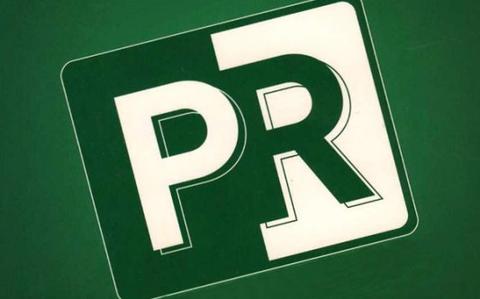
TOP 12 TIPS TO ENGAGE THE MEDIA
Getting the attention of top-tier and targeted media outlets in today’s media-frenzied world is crucial to increasing public interest in any business, product, or person. Media placements, be it a news story, a human-interest story, or a product review, impacts how the consumer gathers knowledge, learns about trends, and makes decisions.
The job of any good PR specialist is to understand the inner-workings of the media so they can recognize what, when, how and to whom to pitch a story that gets media attention and ultimately the attention of consumer.
The good news is that all media outlets need content, be it hourly, daily, weekly, or monthly. So how does the media determine what stories to cover? And what does a PR pro do to engage the media?
Be it Google or Yahoo, a broadcast news program, a radio show, a magazine, a local newspaper, or a blog, media coverage for your client is key to any successful PR campaign.
While there is no magic formula, AJGpr offers some insight and 12 tips on how a PR specialist or publicist can best engage the media.
- First and foremost ask yourself this question. Is your story/news item actually interesting, important, relevant, or “newsy” enough to warrant attention?
- Does the story write its own headline?
- Does it affect a lot of people, or have relevance to a large sector of the population?
- Does it help resolve or answer a current national or local news question?
- Does it offer an interesting argument, debate, or conflict?
- Is it a medical breakthrough or provide answers to recent research, studies, and surveys?
- Is it a human-interest story? Does it evoke humor or sadness? Is it offbeat or quirky?
- Is it a new product that will change peoples’ lives?
- Is it celebrity related? Famous people tend to get more news coverage than the average Joe.
- Do your research. You must be familiar with the media outlet before you pitch. There is nothing that aggravates a producer/editor more than a PR specialist who haphazardly pitches and presents cookie-cutter releases without understanding the needs of the producer/editor.
- Know the media outlets audience. A media outlet or publication that specializes in a topic (e.g. health, women’s interest, sports, parenting) will have a different focus, or different ideas about what is newsworthy and what isn’t. Both localized and national media outlets have their own set of requirements on what they will or will not run.
- Share your pitch with the right producer/editor. Don’t pitch to someone who doesn’t cover the topic you want featured. Find out as much information as you can about them. Know what stories have been produced/published by the producer/editor – and perhaps make mention of that in your pitch.
- Build and honest and casual relationship with producers/editors. Know their first and last name. And most important — respect their time – and when they are on deadline (which is often the case). Bombarding them with email and phone calls will not make them your ally.
- Try to have face time to introduce yourself and your clients when possible. While producers/editors are busy they are often amenable to desk-side meetings. This personal rapport helps you establish trust and long-term relationships.
- Write pitches that are personal and pertinent. Pitches must have a unique/simple angle to avoid ending up in the trash. Remember, the media needs good stories, but be wary of sounding too much like a sales pitch.
- Offer a compelling quote a snazzy sound bite that will stick in the minds of their viewers, listeners or readers.
- Using visuals — photos/ videos that are high quality can enhance your written pitch.
- Offer samples – a book, a product. But send ONLY if requested. Unsolicited books/products often remain unopened.
- Create compelling subject titles when pitching by email. Producers/editors get inundated with email. Make yours stand out. An enticing subject is your next priority after your pitch has been crafted.
- Follow-up is key. Today, producers and editors tend to choose email over the phone to respond to pitches. But if your email pitch falls on deaf ears, don’t be afraid to follow-up by phone and then again by email.
- Once a producer/editor is engaged or shows interest in your story, respond to there query or request for product promptly.
- Always be gracious. It is never too much to say thank you. After a segment has aired or story makes it to print. Draft a quick note of thanks to the producer/editor. This will help secure long-lasing relationships with your media contacts.
Follow these 12 tips and you are on your way to getting media attention for your client managing a successful PR campaign.



